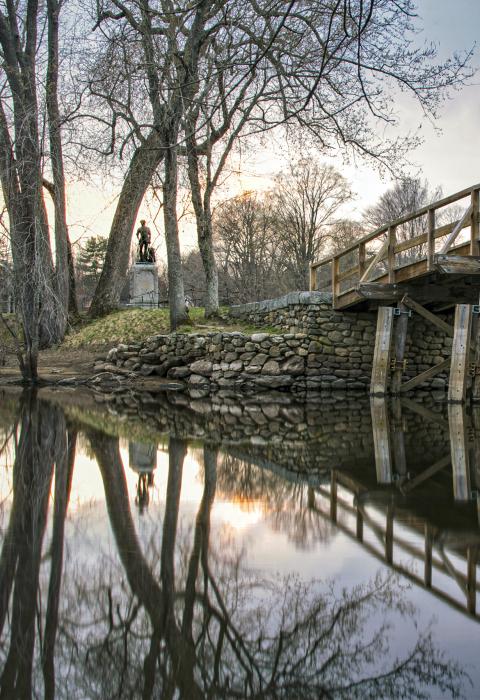Sudbury, Assabet and Concord Rivers
Massachusetts
Located 25 miles west of Boston, these rivers are recognized for their outstanding ecology, history, scenery, recreation values, and place in American literature. Portions of the segments lie within Great Meadows National Wildlife Refuge, and among the many historic sites along the rivers is North Bridge at Minute Man National Historical Park in Concord, site of the revolutionary "shot heard 'round the world." The rivers are managed by the National Park Service in cooperation with the SuAsCo River Stewardship Council, which includes members from local towns, state government, and advocacy groups.
Designated Reach
April 9, 1999. The 14.9-mile segment of the Sudbury River beginning at the Danforth Street Bridge in the town of Framingham, downstream to the Route 2 Bridge in Concord. The 1.7-mile segment of the Sudbury River from the Route 2 Bridge downstream to its confluence with the Assabet River at Egg Rock. The 4.4-mile segment of the Assabet River beginning 1,000 feet downstream from the Damon Mill Dam in the town of Concord, to its confluence with the Sudbury River at Egg Rock in Concord. The eight-mile segment of the Concord River from Egg Rock at the confluence of the Sudbury and Assabet Rivers downstream to the Route 3 Bridge in the town of Billerica.
Outstandingly Remarkable Values
Ecology
The Sudbury, Assabet, and Concord rivers provide extensive aquatic and riparian habitat for abundant and diverse plants and animals. The wetlands associated with the rivers, especially those within and adjacent to the Great Meadows National Wildlife Refuge, contain excellent vegetative conditions for seed crops and wildlife plant food, as well as dense cover habitat for protection and breeding requirements. Over 15 state-certified vernal pools provide essential breeding habitat for amphibians within the rivers' floodplains.
History
The first successful armed resistance of the American Revolution occurred at the North Bridge over the Concord River in Concord, where the Minutemen turned back the British on April 19, 1775. The highest concentration of Revolutionary-era sites along the river occurs close to the confluence of the rivers at Egg Rock. In addition to North Bridge, Colonel Barrett’s farm house still stands along the Assabet River. The Old Manse (on the Concord River) also dates back to the Revolutionary River.
The Concord area and its rivers played an extremely important role in the development of both nineteenth-century transcendentalism and our modern environmental ethic. The authors Henry David Thoreau, Nathaniel Hawthorne, and Ralph Waldo Emerson lived in Concord and wrote about the three rivers.
Prehistory
The Sudbury, Assabet, and Concord river basin possesses one of the highest densities of known prehistoric Native American archaeological sites in Massachusetts. The abundance of aquatic and terrestrial food sources within and alongside the rivers, and the rivers' usefulness as travel corridors, made the study area particularly attractive to Archaic (4000 to 1000 B.C.) and Woodland (1000 to 1600 A.D.) period peoples.
Recreation
It is possible to canoe 29 miles throughout the study area without a single portage, which is unique among the rivers in the region. The boating season is long, lasting from April through early November. The many launch sites add to the rivers’ accessibility and create a variety of possible trip itineraries. In addition, the absence of strong currents allows canoeists to paddle upstream in most of the river, avoiding the inconvenience of a car shuttle. The rivers’ proximity to densely populated areas, such as Boston, put them within an hour’s drive of millions of people.
Scenery
Most of the designated area is remarkable undeveloped, considering the rivers’ proximity to densely populated areas. The scenery within the area is also highly varied, encompassing many regional types.

